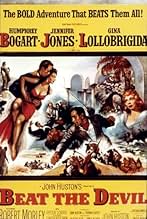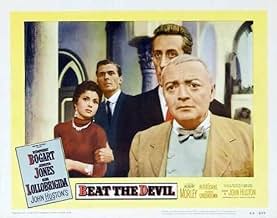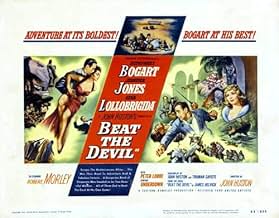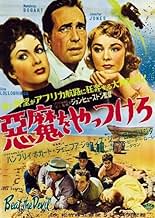Un groupe de voyous en quête de richesse et un couple britannique apparemment innocent sont en route vers l'Afrique. Lorsqu'ils se rencontrent, une série d'événements se déclenche...Un groupe de voyous en quête de richesse et un couple britannique apparemment innocent sont en route vers l'Afrique. Lorsqu'ils se rencontrent, une série d'événements se déclenche...Un groupe de voyous en quête de richesse et un couple britannique apparemment innocent sont en route vers l'Afrique. Lorsqu'ils se rencontrent, une série d'événements se déclenche...
- Prix
- 1 victoire au total
- Captain of SS Nyanga
- (as Saro Urzi)
- Hotel Manager
- (uncredited)
- Barman
- (uncredited)
Avis en vedette
Beat The Devil (directed by John Huston, who co-wrote the script with the up-and-coming Truman Capote) improvises a loose, comic riff on the international adventure genre. Thankfully, it's not unhinged or absurd enough to be a dreaded `spoof,' and emphatically not one (as it's become a commonplace to assume) of the noir cycle. In narrative, point of view and look (there's no coherent visual style), Beat The Devil bears not the slightest resemblance to film noir, which, by this point, was slyly starting to parody itself anyway.
The plot's McGuffin concerns uranium deposits in central Africa, which draw a disreputable and multinational crew of opportunists who hope to strike it rich by sticking it to their various motherlands. The joke lies in that these bumblers keep getting taken in by one another's cover stories, pretensions and lies and falling for one another's spouses. It's not a bad joke, but it needs a bit more rigor to flesh it out from a skit to a feature film.
Of course it's funny, if haphazardly. A blonde Jennifer Jones, juggling an English accent as if with a mouth full of prunes, comes straight out of screwball comedy (who knew?), and Gina Lollobrigida (when not waylaid by her own attempts at English) occasionally matches her. Peter Lorre, looking much like the short and rotund Capote of the future, again displays his instinctive flair for subversive comedy (his past in sinister parts limited what might have been a long and enjoyable career). And Robert Morley, crisp as a toasted if unusually thick crumpet, serves up every line like a butler bearing a decanter of vintage port. Bogart, on the other hand, can't persuasively hide his age and infirmity, and his role as debonair lover and man of action demands superhuman suspension of disbelief (maybe he was just thinking of all the money he was going to lose).
Yet having fun doesn't have to mean that plot is irrelevant, some boring old rule made to be broken. Part of the movie's folklore is that Capote stayed up all night writing the next day's pages; maybe so, but didn't he or Huston know where they were going? Once the characters wade up on the North African shore to be apprehended by `Arabs' (surely, Bedouins?), there's no more pretense of a cohesive script or a halfway satisfying storyline. Finding a plausible way out of all the intrigue, however tongue-in-cheek it might have been, wouldn't have killed the laughs, now, would it?
It looks however as if Beat the Devil may have begun life as a serious thriller. All the business about criminals going after uranium mines in Africa seems fairly original, and is certainly not an archetypal noir plot. And really there is no grand satire here, and no lampooning of specific genre clichés. The story's premise is essentially serious, yet is written with comedy characters and comical mishaps along the way. It's if Huston and his co-writer Truman Capote simply gave up on following it through and instead decided to have a bit of fun with it.
Nevertheless, Huston shoots this one with the same thoughtfulness and precision as he would a drama. As always, he favours set-ups which keep multiple actors in shot together, background and foreground, minimising on cuts between them. With some neat movements he is able to bring the right person to our attention at the right moment, for example the scene in which we first see Humphrey Bogart and Gina Lollobrigida. Bogart paces back and forth in the foreground moving in and out of shot, while Lollobrigida is in mid-shot but sat in the same place, meaning the two of them take turns to be the focal point without lots of editing or obtrusive camera-work. Another neat touch is when the major approaches Bogart at the outdoor table, starting off in the background as if an extra, until it becomes apparent he is worth taking note of. Huston's technique is about elaborate arrangement to keep all characters involved and performances intact without the distractions of film form.
And here there are many characters and performances worth looking at. As befitting for the tone, this is a real outing for oddball supporting players. Peter Lorre is at his very best, all shiftiness and lethargic mannerisms, while Robert Morley gleefully portrays his blustering and conspicuous opposite, and Ivor Barnard hams up his caricature of the puffed-up ex-army fascist. It appears these three fine character actors have been told to simply let go and play their familiar types to the hilt. By contrast, lesser-known Italian Marco Tulli gives a far more restrained performance, but he is in a way the funniest. There's a great moment somewhere in there while the other three are bickering and he is just sat in the middle of the shot, quietly blinking away like some daft meerkat. Even the tiniest roles are filled – often impeccably – by comedy players, many of whom are not well-known in English-language cinema. There's also a great turn by Jennifer Jones, at her most comical and almost unrecognisable as an eccentric Englishwoman, showing superb comic timing as she casually beats her husband at chess. With so much scene-stealing going on, it's possible to forget this is ostensibly a Humphrey Bogart movie.
But while Beat the Devil is full of quirky characters and has numerous funny little moments, it doesn't have much point beside that. The humour is never exactly hilarious because the whole thing really doesn't seem conceived as a comedy. There's not enough of the interaction between crazy characters and sane world which drives wild comedy (such as the Marx Brothers), because in Beat the Devil virtually everyone and everything is crazy. Meanwhile the only completely straight characters (Bogart and Lollobrigida) are simply dull marginalised figures who exist separately from the comedy yet don't have the strength to perk up their end of the movie. Overall it is just a chaotic mess that happens to be worth a chuckle here and there.
The 1953 film had absolutely everything going for it, including Humphrey Bogart, Jennifer Jones, Gina Lollabrigida, Peter Lorre, Robert Morley, directed by John Huston with a screenplay by Truman Capote. What more could you ask for? I don't know, but something.
The story concerns crooks stuck in Italy while they wait for a steamer to be repaired that is to take them to Africa. There, they will buy land that has uranium on it, though no one knows that. They're allegedly selling vacuum cleaners. Also traveling on this steamer are a British woman (Jones) and her husband. He supposedly is landed gentry in England, but is he? The crooks wonder what he's up to, and the wife keeps changing her story.
There is a lot of humor to be had in this film - the situation is funny, the denouement is wonderful, there is some witty dialogue and there are clever situations that go on during the film that are amusing. The problem is that nobody cares.
The film, which looks like it cost about a dollar to make, is too disjointed, and there are long sections where nothing interesting happens.
One of the posters, who really liked the film, commented that people don't like it because the actors aren't going for laughs. Well, I'm not one of those people. Acting 101 says you don't go for laughs - you play the situation and the characters for real and the laughs happen. That doesn't mean, however, that you pace it like it's Long Days Journey. Bogart had wonderful timing no matter what, and it's evident here, particularly in the car scene on the way to the restaurant, where the character's glibness is apparent. The problem isn't in any person, it's in the direction. I don't believe Huston had a sense of comedy. He could be brilliant, but this was not his thing.
Still, "Beat the Devil" is worth seeing, but it's hard to keep your attention on it.
A riotous, imperfect, silly, brazen, forward thinking, throwaway, brilliant spoof.
For starters, you know something will happen with Huston directing Bogart. And throw in an aging bulging Peter Lorre as a German named O'Hara. O'Hara comes into a room and says to Bogart, playing a disaffected American, "Why do you always make jokes about my name, huh? In Chile the name of O'Hara is, is a tip top name. Many Germans in Chile have become to be called O'Hara."
And so there is a dig at a lot of stereotypes, most of them with shades of truth. The style of the film is not film noir, as many people say, but more just an intrigue or war time spy film. The most direct connection seems to be Huston's own Maltese Falcon, but even this is based on Bogart and Lorre appearing in both films (as well as a fun appearance in Beat the Devil by Robert Morely doing a kind of less pleasant Sidney Greenstreet).
I sensed a lot of direct influence from Lady from Shanghai, an overlooked and frankly brilliant and daring Orson Welles film from a few years earlier. Check out the slightly surreal plot, the strange sequences of locations (land, boat, land, with an exotic overture in the middle), and the characters themselves, including Jennifer Jones as a kind of decorative female not unlike Rita Hayworth in Shanghai. There is even a man-to-man discussion of Heyworth in Beat the Devil between Bogart and a unlikely Muslim captor in a generally hilarious scene.
The film is flawed by its own excesses at times, and by a kind of frivolousness that Welles, for one, avoided by making his film's excesses more formal and less literary. Huston, like Bogart, was literate by nature, as a lot of heavy drinking men were in those days, and the dialog, as brilliant as it is (and shepherded along by Huston and Truman Capote in tandem), isn't always in synch with the acting, and with the flow of events. So if we don't really expect anything from the plot, per se, knowing it's all just in fun, we come to expect more from the series of remarks, the twists of fate, and the yawning expectations of an audience used to very high quality writing and acting by 1953.
I know some people who just can't finish watching this because it strikes them as phony and childish. Bogart might agree--he lost money on the production. But there are some great moments, and an ongoing repartee that works well, or works superbly, at different moments. I'd cash out a couple of actors for others more idiosyncratic, I think. But no one asked me, I know. Watch it for what it is. And check out Lady from Shanghai and see if you see what I mean.
Jennifer Jones, beautiful as always, seems barely able to stay inside her role, laughter threatening to break out at any moment. Humphrey Bogart has a recurrent quizzical "Am I really doing this?" expression.
Tied in with a gang of bumbling crooks seeking a fortune in uranium in Africa, illicitly of course, Bogart, married to a cute Gina Lollabrigida, falls in love with a faux English gentleman's wife as fast as his spouse goes for the supposed representative of the landed gentry. Of course cuddling and sweet words substitute for sex.
Robert Morley, always funny, is the putative leader of a gang that can't get their act together with Peter Lorre shedding his customary menacing stare for a busman's holiday as a gangster with a sense of humor.
The action ranges from beautiful Italy to a placid sea voyage aboard a rickety tub commanded by a rum-soaked moron whose Italian expletives are not understandable but who cares? The main characters, shipwrecked, wind up on an African shore where they're greeted by what today are embarrassingly stereotyped Arabs (I cringed at one of the European's comic invocation of Islam but then the movie has to be taken on its own terms and time, right?).
The resolution is lame - the characters all look ready to leave the set and get drunk before undertaking a new film. But this is one of the best spoofs of the noir genre and what makes it fly is the ensemble of first-rate actors in roles neatly the opposite of those they were usually seen performing.
Rent it! (Please)
Le saviez-vous
- AnecdotesHumphrey Bogart was involved in a serious automobile accident during production of this film, which knocked out several of his teeth and hindered his ability to speak. John Huston reportedly hired a young British actor noted for his mimicry skills to rerecord some of Bogart's spoken lines during post-production looping. Although it is undetectable when viewing the film today, it is Peter Sellers who provides Bogart's voice during some of the scenes in this movie. However this cannot be confirmed.
- GaffesBogie enters the lifeboat wearing a plain suit but gets out wearing a pinstriped suit.
- Citations
Julius O'Hara: Time. Time. What is time? Swiss manufacture it. French hoard it. Italians squander it. Americans say it is money. Hindus say it does not exist. Do you know what I say? I say time is a crook.
- Autres versionsThe original American release version was truncated and had scenes moved around, making a mess of the story line. The uncut version--released overseas by Romulus--was finally restored in the U.S. by Sony in 2016.
- ConnexionsEdited into Your Afternoon Movie: Beat the Devil (2022)
Meilleurs choix
- How long is Beat the Devil?Propulsé par Alexa
Détails
Box-office
- Budget
- 1 000 000 $ US (estimation)
- Durée1 heure 29 minutes
- Couleur
- Rapport de forme
- 1.37 : 1
Contribuer à cette page





































